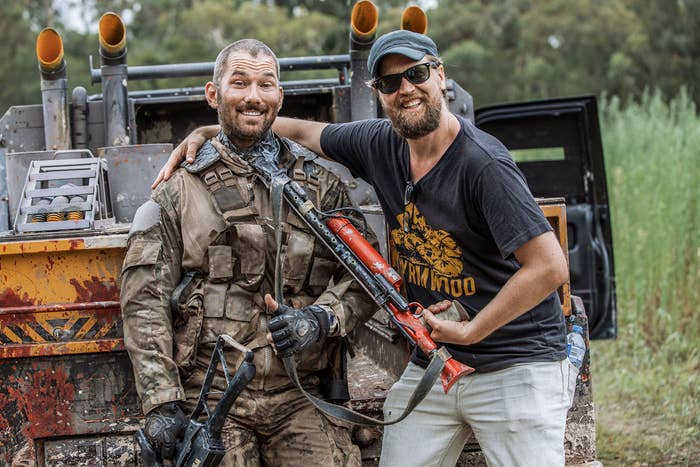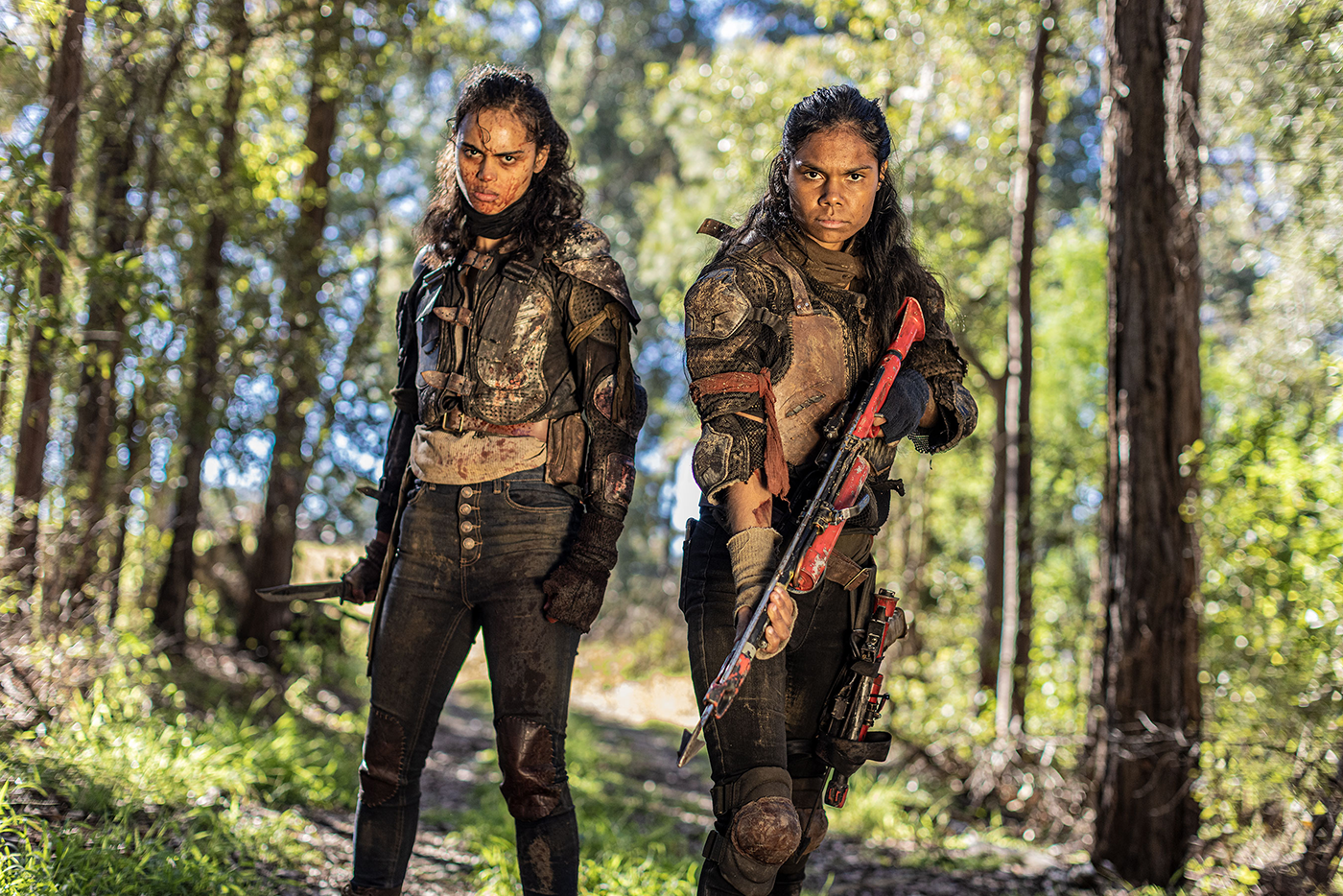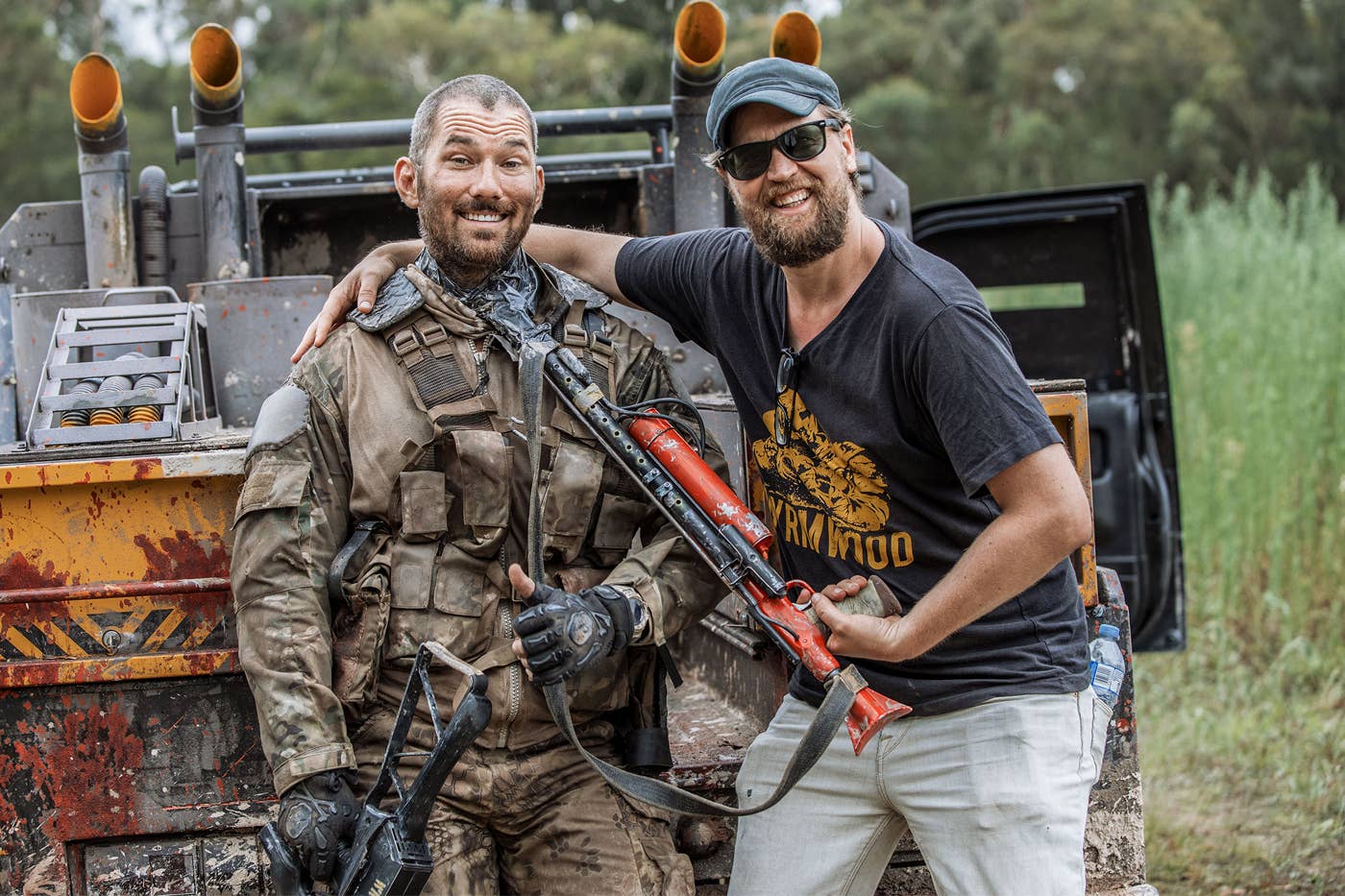
After a lifetime of making short films together, in 2014, Australian brothers Kiah and Tristan Roache-Turner got their big break with the release of Wyrmwood: Road of the Dead, a quintessentially Australian take on the zombie apocalypse. They had worked on the feature film on weekends over three and a half years, financing the project through crowdfunding and their personal savings and enlisting friends and family as cast, crew and extras. The film received unexpected international attention, with reviews in The New York Times, The Hollywood Reporter and Variety, and achieved cult status among horror zombie genre devotees. After 2018’s Nektrotronic, a sci-fi horror studio film starring Italian actress Monica Belluci, the duo have gone back to their roots with Wyrmwood: Apocalypse. In cinemas from February 10, the film sees the Roache-Turners reenter the universe where it all began to apply the expertise they’ve gleaned over the last seven years to the ongoing outback zombie apocalypse.
Ahead of the cinema release of Wyrmwood: Apocalypse, Complex AU sat down with Kiah Roache-Turner to discuss the darkness of Australian cinema, exorcising one’s fears through art, and the challenges of balancing art and commerce.
You and your brother Tristan have been making films together since childhood. Do you remember the first film you ever made?
That would have been around 1990, when I got my hands on a $200 Hi8 camera. The first thing we shot was pretty prophetic. It was a short film of me chopping up my younger brother and putting him in a bag, with absolutely no story. We showed it to our mother and she just burst into tears and said, “What have you done to my baby?” We realised you can really affect people with the cheapest tomato sauce splattered horror movie made in your kitchen. We just got hooked from then.
On the note of DIY filmmaking, I went back and looked at the crowdfunding page for Wyrmwood: Road of the Dead and saw that you offered very creative perks, including a chance to be a zombie extra for $500. With Nektrotronic and now Wyrmwood: Apocalypse, you had more funding. What was that like, and did you miss anything about the shoestring budget?
When we made the first Wyrmwood, we were just a bunch of kids having fun. The first time you do anything it’s always magical and amazing. We shot it over three and a half years on weekends. It was a real family atmosphere.
Tristan and I had enough savings to buy a house or make a movie and we stupidly made a movie. We didn’t really care if we made money or if it was just released on YouTube.
For whatever reason it hit a bit of the zeitgeist and has allowed us to have a career. It got reviewed well in The New York Times, which blew my mind given it was partially shot in my mother’s backyard! It was amazing to do something on such a small scale and have global success.
After that we got a shot at making a studio film, which was a totally different experience. Nektrotronic was a proper studio film, where every single creative decision was made by seven people, which isn’t the best way to make art. Art has to be risky, but nobody wants to risk $10 million dollars. The hardest part about being a filmmaker is navigating the grey area where money meets art. Directors like Taika Waititi, Steven Spielberg, Christopher Nolan and Guillermo Del Toro are able to make blockbuster films that are still wonderful pieces of art; I’d love to know how they do it!
With Wyrmwood: Apocalypse we wanted to have just enough money to lift the production and apply what we’ve learned in the seven years that we’ve been “industry professionals”, but keep the same spirit of family and friendship of the first film. We also wanted to keep the budget small enough to retain creative control of the final cut, which is very rare.
The first Wyrmwood kicks off with a man forced to shoot his wife and child with a nail gun. This one has a scene that threatens death by zombies eating you “from the legs to the balls to the guts.”
Yes, almost like a religious crucifixion! We were raised Catholic…
Very biblical! What is it about violence that you are drawn to? And why do you think violence is so integral to Australian film?
If you spend five minutes looking at our history, it’s a brutal history. White people came here and just took the land violently from the Indigenous population. Our culture is birthed in violence and slaughter… yet we have such beautiful beaches! There’s a dichotomy where a lot of our art is brutal, but still has a laconic humour and easygoing charm.
I don’t know where my violent stuff comes from. I had a very lovely childhood and my mum is an ex-nun, so I have no excuse! I don’t like violence in real life; I find it terrifying. I was a kid who had to sleep with the light on because of the monsters under the bed. I make horror films because I’m trying to exorcise that fear. That’s an intellectual answer, but I’ve also just always liked violent comic books like Punisher and movies like Mad Max (1979) and the Evil Dead series. I just like on-screen dynamism and an easy way to get that is to watch an ‘80s Arnold Schwarzenegger shoot-em-up film.
To what you said about Australia’s history, the film starts off with a showdown between sisters Grace and Maxi and siblings Brooke and Barry. One of the sisters says, “You’re all monsters. You’re both the fucking same.” Given the sisters are Aboriginal and Brooke and Barry are white, did race factor into that scene? It was on my mind as I watched Grace being held captive in the outback and delivered to a group of white men.
No, not at all, but that’s really interesting. I write what feels natural and people like yourself bring intellectual and historical weight to the reviews. It’s fascinating to me that you’ve drawn that conclusion.
Grace is horrified by the monsters she’s travelling with, but by the end of the film she’s had to become a monster to survive. In times of war or extreme history, sometimes you have to find the monster inside of yourself to get to the other side.
View this video on YouTube
I saw an interview where you or Tristan said you “weren’t trying to communicate anything” through Wyrmwood: Road of the Dead, but were just making a genre movie for fans. Is that accurate?
If you’re writing from a political standpoint, you better have your stuff really tight. I didn’t really want to make it overtly political. People keep asking about the Indigenous content in the films. If I’m completely truthful, the Indigenous content in the first film was simply because Leon Burchill was the best guy for the part. I didn’t think of Benny as an “Indigenous role”; Leon was just the best actor available and he made suggestions that contributed to the mythology of the film.
In the new film we have actors Shantae Barnes-Cowan and Tasia Zalar as sisters Maxi and Grace, who are Benny’s nieces. It was pretty important to me that we didn’t push Indigenous themes, because as a white filmmaker it’s not really my prerogative or right to do that. I just cast the best people for the parts. Of course that’s a flippant answer and identity does come to bear, but I’d rather people make their own conclusions rather than have me spoon feed anything.
Given the pandemic and questions of political authoritarianism, people will certainly find their own meaning in the film.
Everybody is political, so whatever position I have works its way into the script naturally. But I don’t see cinema as a position from which you can preach. I think it’s a position from which you can tell stories. But of course my themes are all there: I have an inherent, naive belief in the power of good vs evil, and in connection and family getting you through difficult times. These are all themes that are relevant to what we’re going through now. It’s really weird I was making a film about a viral pandemic where people are wearing masks and suddenly we’re all shooting in the same conditions.
Totally! When and where did you shoot this film?
We shot it out near Dural, New South Wales, on an old fruit farm that’s recently been turned into a film production area. We started shooting at the beginning of the lockdown. There were only seven cases in New South Wales at the time, but we were very careful to create a safe bubble and only shot at one location. Noone got covid, or even a cold. We were the healthiest 100 people in Australia at the time!



